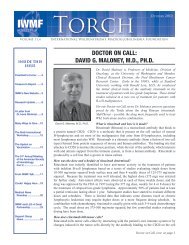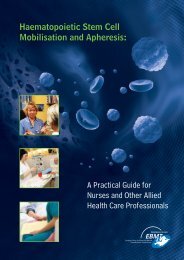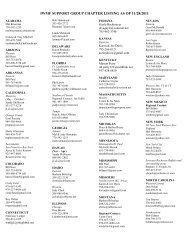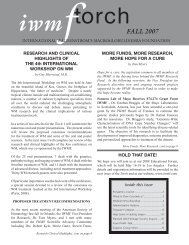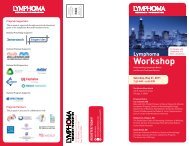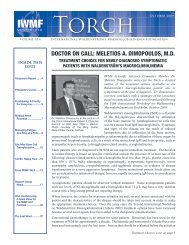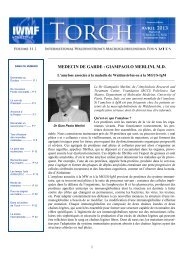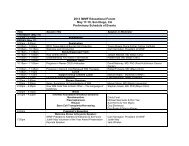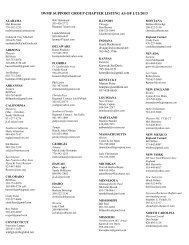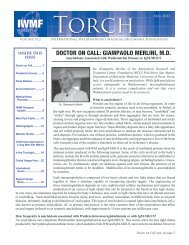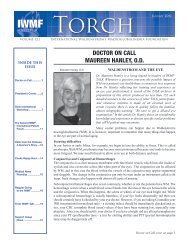English - International Waldenstrom's Macroglobulinemia Foundation
English - International Waldenstrom's Macroglobulinemia Foundation
English - International Waldenstrom's Macroglobulinemia Foundation
Create successful ePaper yourself
Turn your PDF publications into a flip-book with our unique Google optimized e-Paper software.
Medical News Roundup, cont. from page 10<br />
Cellulaire examined the long-term outcome of allogeneic stem<br />
cell transplantation (SCT) in WM by studying the records of<br />
24 patients. Median age at the time of transplantation was<br />
48 years, and patients had previously received a median of<br />
three lines of therapy beforehand. The overall response rate<br />
after transplantation was 92%, with a complete response<br />
rate of 50%. After a median follow-up of 64 months, the<br />
5-year overall survival rate was 67% and the progressionfree<br />
survival rate was 58%. The authors concluded that<br />
allogeneic SCT yields a high rate of complete remissions and<br />
is potentially curative in poor-risk WM.<br />
United Kingdom Cancer Survivors to Receive Additional<br />
Support and Services – The United Kingdom Department of<br />
Health and Macmillan Cancer Support have jointly announced<br />
that cancer survivors in the UK will receive additional<br />
support and services under a plan, called the National Cancer<br />
Survivorship Initiative, to be put in place by 2012. Cancer<br />
survivors will have a personalized assessment and care plan,<br />
support to self-manage their condition, information on the<br />
long-term effects of living with and beyond cancer, and<br />
access to specialists for complications that can occur after<br />
cancer. Pilot studies for this program are being established in<br />
38 sites around the country.<br />
Australian Study Reports on Significance of Persistent<br />
Cytopenias Following Fludarabine Treatment – The Peter<br />
MacCallum Cancer Centre and the University of Melbourne<br />
in Australia reported on the presence and significance of<br />
prolonged cytopenias (low hemoglobin, neutrophils, and/<br />
or platelet counts) after completion of treatment with<br />
fludarabine-based therapy. The study included 61 patients<br />
and noted that persistent cytopenias were found in 43%<br />
of patients. These cytopenias, while unrelated to disease<br />
status, were associated with important rates of infection<br />
and transfusion requirements. Persistent cytopenias also<br />
predicted worse overall survival. Increasing age appeared to<br />
increase the risk of persistent cytopenias while dose intensity<br />
did not appear to be a factor.<br />
New Proteasome Inhibitor Tested by Dana-Farber Cancer<br />
Institute – Dana-Farber Cancer Institute has conducted<br />
studies on WM cells with a new proteasome inhibitor called<br />
ONX0912. Since a significant fraction of patients relapse after<br />
bortezomib treatment, this newer inhibitor of chymotrypsinlike<br />
activity of the proteasome may represent a valid antitumor<br />
therapy in WM because it induces apoptosis (cell<br />
death) and reduces expression of several proteins produced<br />
by bone marrow cells and implicated in WM cell growth.<br />
Bayer Tests NHL Vaccine Developed from Tobacco<br />
Plants – Bayer has begun a Phase I study with a personalized<br />
vaccine for non-Hodgkin’s lymphoma patients developed<br />
from tobacco plants. The company uses tobacco plants in<br />
order to produce a high yield of idiotype (tumor-specific)<br />
vaccines for treatment of B-cell lymphomas. In this process,<br />
the tobacco plant is not genetically modified; instead, the<br />
blueprint for the required product is inserted temporarily into<br />
the plant by a species of bacteria and distributed throughout<br />
the plant cells. The vaccine is subsequently extracted from<br />
the plant’s leaves in a pure form and is used to stimulate an<br />
immune response against the cancerous cells when injected<br />
into the patient. In this study, 20 patients will each be given<br />
six subcutaneous injections of the vaccine over a six-month<br />
period. The clinical study will be performed at the University<br />
of Texas Southwestern Medical Center in Dallas.<br />
Mayo Clinic Reports on Phase I Trial of Rituximab and<br />
Interleukin-12 – Mayo Clinic conducted a Phase I trial<br />
of interleukin-12 (IL-12) in combination with rituximab<br />
for non-Hodgkin’s lymphoma. IL-12 facilitates the T-cell<br />
response, enhancing the killing activity of natural killer cells<br />
and inducing the secretion of interferon. Objective responses<br />
occurred in 29 of the 43 patients (69%) in the study, with<br />
several complete responses. The optimal dose of IL-12 was<br />
determined to be 300 ng/kg administered subcutaneously<br />
twice weekly.<br />
German Drug Company Is Conducting Phase I Trial<br />
of New Drug for Lymphomas – 4SC AG, a German drug<br />
discovery and development company focused on autoimmune<br />
and cancer conditions, announced a Phase I study evaluating<br />
4SC-205, an oral Eg5 kinesin spindle protein inhibitor, in<br />
patients with solid tumors and lymphomas. Eg5 kinesin<br />
spindle protein is important for proper cell division – its<br />
inhibition leads to cell cycle arrest and apoptosis (cell death).<br />
Since the expression of Eg5 is confined to actively dividing<br />
cells, it is hoped that the drug will have an acceptable toxicity<br />
profile.<br />
Dana-Farber Plans Study of New Oral Drug Called<br />
Panobinostat in WM Patients – Dana-Farber Cancer<br />
Institute is currently recruiting patients for a Phase II study<br />
of panobinostat (LBH-589) in relapsed/refractory WM.<br />
Panobinostat is an oral drug, developed by Novartis, that<br />
is being tested in multiple myeloma and several types of<br />
leukemia and lymphoma. It inhibits the enzyme histone<br />
deacetylase, leading to apoptosis (death) of malignant cells<br />
via multiple pathways.<br />
New Fusion Protein of Anti-CD20 Antibody and Interferon<br />
Improves Rituximab Efficacy – In an effort to improve the<br />
outcome of rituximab therapies and overcome rituximab<br />
resistance, UCLA researchers have constructed a fusion<br />
protein consisting of an anti-CD20 antibody and mouse or<br />
human interferon alpha. Efficacy was established in mouse<br />
models of lymphoma and may represent a useful strategy for<br />
treatment of B-cell malignancies.<br />
The author gratefully acknowledges the efforts of Arlene<br />
Carsten, Peter DeNardis, Mike Dewhirst, Gareth Evans,<br />
Daniel Hachigian, John Paasch, Colin Perrott, Howard<br />
Prestwich, and Bert Visheau in disseminating news of interest<br />
to the IWMF-Talk community.<br />
IWMF TORCH Volume 11.2<br />
11



